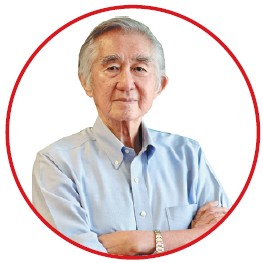
Singapore, Feb 23, 1938
EDUCATION:
1962: Bachelor of architecture, University of New South Wales
1965: Master's in city planning, Yale University
1995: Doctor of science (honorary), University of New South Wales
CAREER:
1969-89: Chief architect and CEO, Housing and Development Board of Singapore
1989-92: Chief planner and CEO, Urban Redevelopment Authority of Singapore
1996-2005: Chairman, National Arts Council of Singapore
2000-09: Chairman, Singapore Tyler Print Institute
1992-2017: Senior director, RSP Architects Planners and Engineers
2008-present: Founding chairman, advisory board of the Centre for Livable Cities
2017-present: Chairman, Morrow Architects& Planners
AWARDS:
2001: Medal of the City of Paris, France
2014: Business China Excellence Award
2015: Singapore Institute of Planners' Distinguished Lifetime Achievement Award
MAJOR PROJECTS IN CHINA:
1997: Fuzhou Changle International Airport, Fujian province, 120,000 square meters
2002: Huafa Xincheng, Zhuhai, Guangdong province, 450,000 sq m
2011: Weifang Cultural Center, Shandong province, 294,000 sq m
2011: Guilin Watermark Lijiang Residential Development, Guangxi Zhuang autonomous region, 116,000 sq m
AWARDS FROM CHINESE AUTHORITIES:
2011: China Construction Engineering Luban Award for Weifang Workers' Hall and Youth Hall
2015: Jinan Wenbo CBD Planning Award
2016: Weifang Planning Award
The man who helped design China's urban landscape

He is best known as Singapore's "father of city planning", but Liu Thai Ker can also boast of having a hand in shaping the urban landscape in China.
You could say it started in 1978, when Deng Xiaoping visited Singapore.
"I was asked to take care of him as I could speak Mandarin well," recalled Liu, the chairman of Morrow Architects & Planners, who served as chief planner and CEO of Singapore's Urban Redevelopment Authority from 1989 to 1992.
Deng was taken to the rooftop of the Ministry of National Development building, where Liu explained Singapore's urban planning.
"I like to think that partly because of that, when Deng went back to China a few months later, he made the announcement (that China would learn) urban planning from Singapore," Liu, 80, said.
Back then, Liu was a junior staff member at the Housing and Development Board of Singapore, where he rose to become chief architect and CEO.
"I was an ignorant young man, but I knew that Deng was a very important reformer for China," he said. "He was very down-to-earth with no airs. He asked pointed, practical questions. I was very comfortable briefing him. He made a very good impression."
A year later, Liu made his first visit to China, where he made stops in Beijing, Tianjin and Shanghai, and had the chance to see the country at the start of reform and opening-up.
"I saw the historic parts of Beijing, with a lot of siheyuan," he said, referring to the capital's traditional courtyard homes. "Unfortunately, most of them are gone already.
"In those days, people in the street wore either black or blue colors. They were very drab-looking, and yet the historic buildings were so beautiful."
It wasn't until the early 1980s that Liu received his first commission to plan a city in China - Fuzhou, the capital of Fujian province - through the Singapore government.
His experience on the topic stems from planning new towns for Singapore, each capable of accommodating about 200,000 people. By the end of his 20-year HDB career in 1989, he had created 23 new towns, including public housing and complementary facilities and amenities for their residents, such as playgrounds for the children, and community centers for recreational activities.
"When I did the planning at HDB, I also planned the surroundings to protect the neighborhoods," Liu said. "This meant I would have to keep updated on the urban plan of Singapore. By extension, I had no problems planning a city."


